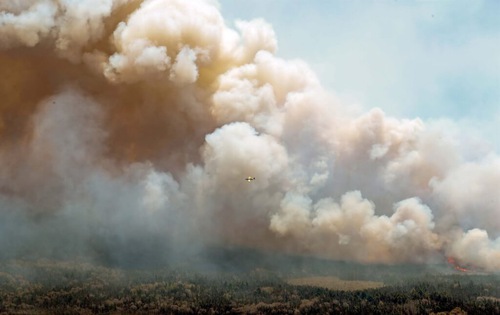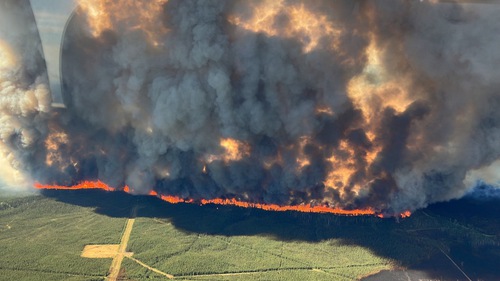(Minghui.org) The wildfires in the Canadian forests that started in the early summer of 2023 continued to spread with no signs of abating. Tens of thousands of Canadians were forced to evacuate their homes.
Central News Agency reported that black smoke from wildfires moved southward, causing dozens of states in the United States to issue air pollution alerts. New York City became the city with the worst air quality in the world on June 6.
According to the smoke forecast website BlueSky Canada, most of Canada would be covered in black smoke on June 8. The situation in places such as Ottawa and Toronto, as well as Cleveland and Pittsburgh in the United States, would get worse. Cities along the east coast of the United States, including New York, would also have thick black smoke entrenched in the sky.
Canadian Prime Minister Justin Trudeau described it as the worst wildfire season on record in the country.
As of June 7, the United States has dispatched more than 600 firefighters and helpers, as well as other equipment. Many more are on their way. The European Union is sending nearly 300 firefighters to assist Canada in the fight against wildfires.
 The forest fire spread in Canada. A plane sprayed water and fire retardant from the sky on June 1 in New Brunswick Province. (Official website of Nova Scotia, Canada)
The forest fire spread in Canada. A plane sprayed water and fire retardant from the sky on June 1 in New Brunswick Province. (Official website of Nova Scotia, Canada)
 Fires have occurred in almost all ten provinces and territories in Canada. The high temperature in early summer has led to more than 400 active forest wildfires, and some fires are still out of control. The picture shows Canadian firefighters fighting the fire. (Screenshot of Canadian Prime Minister’s official Twitter video)
Fires have occurred in almost all ten provinces and territories in Canada. The high temperature in early summer has led to more than 400 active forest wildfires, and some fires are still out of control. The picture shows Canadian firefighters fighting the fire. (Screenshot of Canadian Prime Minister’s official Twitter video)
3.8 Million Hectares of Land Burned in Canada, More Than 20,000 People Evacuated from Their Homes
Canada’s 2023 wildfire season started early in May in Alberta. Hundreds of wildfires have so far made city skylines turn gray. More than 20,000 people have been evacuated from their homes as wildfires raged.
Fires are raging in nearly all ten of Canada’s provinces and territories. Early summer heat has led to more than 400 active wildfires, some of which are still out of control. Many of the worst fires are concentrated in the province of Quebec, which borders the northeastern United States.
Although forest fires are common in Canada, simultaneous outbreaks on the east and west coasts are unusual, leaving firefighters exhausted and the government forced to send in the military to help.
The U.S. National Aeronautics and Space Administration (NASA) described Canada’s wildfire season as extraordinarily intense to begin with, with the flames in Quebec sparked by lightning.
About 3.8 million hectares (9.4 million acres) have already burned, some 15 times the 10-year average, said Federal Minister of Emergency Preparedness Bill Blair at a June 7 briefing.
“Across the country as of today, there are 414 wildfires burning, 239 of which are determined to be out of control,” Blair said.
“We’ve seen continued impacts to critical infrastructure in Quebec such as roads and rural closures, telecommunication interruptions, and high voltage power lines being threatened by the growing fires,” Blair remarked.
Quebec Premier Francois Legault earlier said the province was able to fight 40 fires at the same time.
“But we have 150 fires so we have to make sure that we focus where the problems are more urgent,” he told reporters.
About 520 Firefighters Fighting the Blaze
 The wildfire at Donnie Creek in northern British Columbia. (B.C. Wildfire Service)
The wildfire at Donnie Creek in northern British Columbia. (B.C. Wildfire Service)
Rob Schweitzer is the executive director of BC Wildfire Service, a part of the government of British Columbia. He said lightning strikes could start more fires in dry forests, depending on how much rain comes with the storms.
“When you get 150 or 200 strikes in one day from lightning coming through the province, it’s impossible to have enough resources to suppress them all,” he said.
Wildfires have eased in Alberta, the center of Canada’s oil and gas industry. But more than 3,000 people remain under evacuation orders and heat warnings are in effect in the south of the province.
Quebec Premier François Legault pointed out that about 520 firefighters are currently “fighting” with the blaze, and another 150 soldiers would soon come for reinforcements. He hopes that 500 people will arrive in the next few days from neighboring provinces as well as France, the United States, Portugal, Spain and Mexico to help fight the fire.
Dozens of U.S. states issue air pollution alerts
The U.S. Environmental Protection Agency (EPA) stated smoke from wildfires in Canada drifted across the Northeast, to Chicago in the west and Atlanta in the south, putting more than 100 million people under air pollution alerts.
Polluted air is sending asthmatic patients to the doctor, delaying thousands of flights, shutting down Broadway performances, postponing professional sports events and forcing people to wear masks again, work remotely and schools to temporarily adjust start times.
New York City was named the city with the worst air quality in the world on June 6. New York Mayor Eric Adams advised all New Yorkers to limit their outdoor activities as much as possible, especially those with heart or breathing problems, children, and the elderly. Outdoor activities at all New York City public schools were canceled on June 7 as smog and air quality reached “very unhealthy” levels.
According to the air quality tracking platform AirNow, New York City’s air quality index (AQI) broke through 400, reaching the “hazardous” level, and the worst record since the US Environmental Protection Agency (EPA) began tracking in 1999. The Bronx, where the Yankees are located, has had the worst air quality among the five boroughs of New York City.
 The sky in New York City is an eerie orange due to the smog. (New York City Government official website)
The sky in New York City is an eerie orange due to the smog. (New York City Government official website)
The sky over New York City has been gray and orange most of the time since June 6. Many people reported that the air has a burning smell, and the number of people wearing masks outdoors has increased significantly.
New York City Health and Mental Hygiene Commissioner Ashwin Vasan said that New York’s air quality was the worst since the 1960s.
Dozens of states in the United States issued air quality alerts on June 7. Health officials in Vermont and South Carolina on the east coast of the United States, Ohio, and Kansas in the Midwest also called on millions of people to reduce their outdoor time and warned that airborne particulates may cause breathing difficulties and health risks.
Experts from the US National Weather Service said that it was a low-pressure system over the US state of Maine and the Canadian province of Nova Scotia that was driving the Canada/US heavy smog. The weather system is likely to remain in place for at least the next few days.
All content published on this website is copyrighted by Minghui.org. Non-commercial reproduction must include attribution (e.g. "As reported by Minghui.org, ...") and a link to the original article. For commercial use, contact our editorial department for permission.
Category: News & Events










